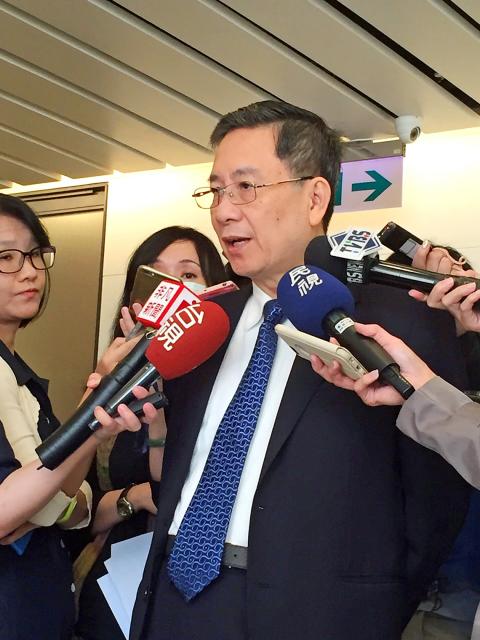It comes as no surprise that there’s a shortage of talent in Taiwan. According to the chairman of the Yuanta-Polaris Research Institute, Liang Kuo-yuan, key factors behind the shortage include a declining birth rate and aging society, the brain-drain and the failure of joint programs by academia and industry to supply job market demand. Liang fears this problem is only set to become worse in the future.
Liang says the trend of a declining birth rate and an aging society has meant that, last year, Taiwan’s population went into a decline, leading to a shrinking of the talent pool.
Meanwhile, the high quality talent that Taiwan has worked hard to nurture are successively moving abroad due to, among other factors, the long-term situation of salaries not fairly reflecting growth in productivity, world-famous excessive working hours and the difficulty of achieving a work-life balance.

Photo: CNA
照片:中央社
Liang emphasizes that not only are depressed salaries the main factor causing Taiwanese talent to move abroad; foreign talent, also influenced by salary levels, are disinclined to come to Taiwan for work due to the low salary environment, and this has further exacerbated the shortage of talent.
(CNA, translated by Edward Jones)
台灣人才短缺早非新聞,元大寶華綜合經濟研究院院長梁國源預期,受到少子化與 高齡化、人才流失以及產學與市場供需落差等關鍵因素影響,台灣人才短缺問題未來恐持續惡化。
對於台灣人才短缺問題,梁國源表示,少子化與高齡化趨勢,讓台灣人口自二○一五年後轉為減少,大幅縮小了孕育人才的搖籃。
同時,台灣辛苦培育出的高素質人力,由於薪資長年未能合理反映生產力的成長,加上聞名於世的過長工時,難以兼顧工作與生活等因素,紛紛出走海外,尋找待遇與能力相匹配的工作。
梁國源強調,國內薪資環境低落不僅為人才出走的主因,且外國精英也受制於薪資,不傾向赴台灣就業,使人才缺口進一步加深。
(中央社)

Renhe sat stiffly at the Wei Ya banquet, picking at the symbolic dishes on the table. Fish for abundance, sticky rice cake for progress — it all seemed superstitious to him. The shrine to the Land God near the entrance, adorned with offerings, incense, and fruit, struck him as frivolous. “What does this have to do with running a business?” Renhe scrolled on his phone as his co-workers performed skits and poorly sung songs. He wasn’t even paying attention to the lucky draws when his name was called. The room filled with applause and cheers as he went to the stage

Stonefish may not be the most impressive-looking animal in the sea. In fact, this fish is so skilled at camouflage that most people wouldn’t notice it if they swam past it. Despite their unremarkable appearance, stonefish are the most venomous fish in the ocean. Stonefish come in various shades of brown, red, yellow, and orange. Their rough skin texture and blotchy color pattern give them a remarkable resemblance to stones, which is where their name comes from. This feature helps them blend in with their surroundings exceptionally well. Stonefish are notable for their 13 highly venomous spines which protrude

The cocoa industry is currently facing a crisis, with this year’s cocoa trading price soaring to an unprecedented $10,000 per ton—a 400 percent increase from last year—stemming from diminished crop yields. Given cocoa’s indispensable role in chocolate-making, this surge has driven up chocolate prices and triggered concerns about the sustainability of global chocolate production. West Africa, home to over half of the world’s cocoa trees, is at the center of this issue. The Republic of Cote d’Ivoire and the Republic of Ghana, in particular, are facing severe challenges from both natural disasters and human-induced factors, substantially impacting cocoa harvests. Climate change, with

「雙手合十/合掌禮」(namaste) or 「碰肘/擊肘」 (elbow bump): 新冠肺炎流行逐漸改變現代社會的某些社交禮儀,歐美許多名人政要開始以「雙手合十/合掌禮」(namaste) 或「碰肘/擊肘」(elbow bump) 替代握手。 《今日商業》報導英國王儲查爾斯以「雙手合十」代替握手。 Coronavirus update: Prince Charles spotted greeting people with namaste (Business Today , March 12, 2020) 另外,《商業內幕》報導:疫情期間美國總統川普在白宮舉行新冠肺炎記者會,想和居家照護公司LHC集團執行副總葛林斯坦 (Bruce Greenstein) 握手,葛林斯坦婉拒,示意改用擊肘。 President Donald Trump attempted to shake hands with a home health care company executive . . . but the man turned the president down and offered him an elbow bump instead. (Eliza Relman, Business Insider , March 14, 2020) 「雙手合十/合掌禮」源自印度,也流行於泰、緬等國家。「碰肘/擊肘」則是 2006 禽流感、2009 豬流感後逐漸流行。疫情逐漸改變我們的生活方式,包括打招呼等社交禮儀,也出現了微妙的變化。 「拱手禮」(fist-and-palm salute) 至於華人社會傳統上也有雙手互握合於胸前「拱手禮」(fist-and-palm salute)。公益網站 Just Quarantine 提到: Taiwanese president Tsai Ing-wen demonstrating social distancing through use of a traditional Chinese greeting (fist & palm) instead of shaking hands in response to the COVID-19 pandemic. 因應新冠肺炎疫情,2020 當年總統蔡英文與來訪賓客保持安全距離,拱手 (fist &